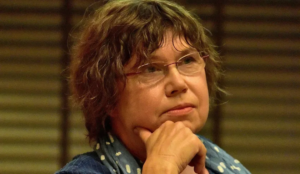








Hiding from Nazis in an Amsterdam annex, Anne Frank peered out an attic window and saw a white horse chestnut tree towering over 188 Keizersgracht’s courtyard as a beacon of hope.
On Feb. 23, 1944, two years into hiding, the young Jewish girl sat in silence as she and Peter van Pels, a Jewish boy hiding with the Franks, gazed at the freedom beyond their reach — outside attic windows, most of which had been blacked out to protect those hiding.
“The two of us looked out at the blue sky, the bare chestnut tree glistening with dew, the seagulls and other birds glinting with silver as they swooped through the air, and we were so moved and entranced that we couldn’t speak,” Frank wrote in her world-famous, posthumously published diary, which references the tree three times. “‘As long as this exists,’ I thought, ‘this sunshine and this cloudless sky, and as long as I can enjoy it, how can I be sad?’”
On Monday morning, a descendent of that same tree was dedicated in Squirrel Hill, as students at a private Jewish day school and their families gathered to mark Yom HaShoah — or Holocaust Remembrance Day.
The new tree — which a state-operated nursery in Indiana grew for eight years from the original Amsterdam tree’s seedlings — was donated to Community Day School. It was planted near the K-8 school’s Holocaust memorial on Forward Avenue thanks to Anne Frank Center USA, a New York City-based nonprofit that focuses on Holocaust education and human rights activism.
“God willing, this tree will last hundreds of years and, God willing, the teachings you’ve learned here will last hundreds of years,” Head of School Avi Baran Munro told a crowd assembled under cloudy skies.
Monday’s ceremony took place at the foot of “Keeping Tabs,” a 45-foot-wide, nearly 9-foot-tall Holocaust sculpture whose 960 glass blocks are filled with soda-can tabs representing the six million Jews the Third Reich killed during World War II.
When seen from above, the sculpture’s disconnected walls form a Star of David, a six-pointed figure symbolizing Judaism and the State of Israel.
“This is a lovely, living reminder of Anne Frank, her life and the ongoing threat of antisemitism,” Pittsburgh City Controller Rachael Heisler told TribLive after the ceremony. Councilwoman Erika Strassburger spoke briefly during the hour-long ceremony and presented school officials with a city proclamation for Holocaust Remembrance Day.
More than a sapling
Initially, the Anne Frank Center USA and Community Day School thought that the tree bound for Pittsburgh was just a tiny sapling.
Anne Frank Center USA CEO Lauren Bairnsfather laughed at that suggestion as she stood in front of the tree, its nearly 12-foot-tall trunk and leafy branches standing over her on Monday morning.
When Bairnsfather, an Edgewood resident who previously led the Holocaust Center of Pittsburgh, heard about the tree’s true size, she rented a U-Haul truck and trekked more than six hours to pick it up from the nursery in Vallonia, Ind., about 70 miles south of Indianapolis.
The first tree of the New York City group’s recent round of donations — most of them to Holocaust educators and memorials — was planted in April at an Omaha, Neb. college, Bairnsfather said. The one brought to Pittsburgh was the second.
In a previous donation round, the center planted trees at the U.S. Capitol in Washington, D.C. and the United Nations building in New York City, Bairnsfather said. Trees also are set to be delivered to Los Angeles’ first synagogue, a White Plains, N.Y. memorial and a Philadelphia college that offers more than 35 courses on Holocaust and genocide studies.
Bairnsfather on Monday detailed Frank’s life and how her years in hiding ended: the German security police raided Frank’s “secret annex” on Aug. 4, 1944; Nazis later took Frank and her sister to the Bergen-Belsen concentration camp in Germany, where Frank died of typhus at age 15 in February 1945.
Nothing is known about her final days.
“The story is so tragic at every turn,” Bairnsfather said.
From a seedling
Robert Hawkins, a supervisor at the Indiana nursery that’s been growing the chestnut’s offspring, said you don’t need to be Jewish to understand the meaning Frank projected onto the tree.
Hawkins told TribLive he re-read Frank’s “Diary of A Young Girl” when he heard he’d be propagating the history-infused chestnut.
“I think this has special meaning because most people have read the diary of Anne Frank,” said Hawkins, 61, of Indianapolis, who studied forestry at Purdue University. “This tree gave her hope when she was in hiding.”
The tree that Hawkins’ nursery fork-lifted into Bairnsfather’s U-Haul to send to Pittsburgh grew from a seedling from the original tree and is genetically identical to it, he said.
Grown and nurtured outdoors for nearly a decade, the tree weighed about 400 lbs when Bairnsfather picked it up last month, Hawkins said. Its bulb, the tree’s underground stem which stores food for periods of dormancy, measured about 3 feet in circumference, she said.
The tree arrived in Squirrel Hill on April 23.
The original tree Frank wrote about was one of the oldest chestnut trees in Amsterdam — an estimated 170 years old, according to Anne Frank Center USA’s website.
In 2005, the Frank tree was diagnosed with a serious disease, which prompted officials to gather seedlings and donate them, the Anne Frank House, a nonprofit formed in Amsterdam in 1957, said on its website.
Four years later, 150 descendants of the tree were donated to a woodland park in the Netherlands. Groups started planting the offspring in the U.S. in 2013. The original tree and its iron supports collapsed in 2010.
‘Forget nothing’
It was a morning of quiet details.
Eighth-graders, dressed in black and white, recalled stories about their own relatives who survived the Holocaust as they stood behind six lighted, votive candles. A group of 11 more students sang a Yiddish protest song — “A Shturemvind,” or “A Storm Wind.”
Teacher Chaim Steinberg, who also serves as the schools’ social justice program coordinator, led somber renditions of the Israeli and U.S. national anthems. Most of the crowd peered through the new chestnut tree’s branches to see the Israeli flag lowered to half-staff.
Many people spoke about the tree’s contemporary relevance as incidents of antisemitism have reached record numbers — both in Pittsburgh and the U.S.
There have been 107 antisemitic incidents reported in Pittsburgh in 2024 — nearly triple the 38 reported from January through May last year, according to Shawn Brokos, the retired 24-year FBI veteran who heads security for the Jewish Federation of Greater Pittsburgh.
The number of antisemitic incidents hit 300 last year, more than a third of them after Hamas stormed Israel Oct. 7, killing and injuring thousands of civilians and triggering war in Palestine’s Gaza Strip.
There were 122 antisemitic incidents in 2022, 82 incidents in 2021, and just 27 in 2017, the year before 11 Jewish congregants were gunned down in Pittsburgh during an Oct. 27, 2018, Shabbat service at Tree of Life-Or L’Simcha synagogue, officials said.
A jury convicted the Squirrel Hill synagogue shooter in federal court last summer; he is on death row.
“With everything that’s going on in the world, it’s important we forget nothing,” said Scott Apter, 77, of White Oak, who has led Community Day School’s grandparent association for seven years. “There’s hatred and evil in the world. And, unless we confront it, it’ll continue forever.”
Munro, the school’s administrator, also drew parallels between Frank’s experience during World War II and modern-day antisemitism.
“Tragically, the calls of the annihilation of the Jewish people … have risen from the ashes,” she said Monday, as she stood in front of the Holocaust sculpture.
“Anyone who’s calling for peace while at the same time calling for the destruction of Jews,” Munro said, “is calling for war, is calling for this again.”
Justin Vellucci is a TribLive reporter covering crime and public safety in Pittsburgh and Allegheny County. A longtime freelance journalist and former reporter for the Asbury Park (N.J.) Press, he worked as a general assignment reporter at the Trib from 2006 to 2009 and returned in 2022. He can be reached at jvellucci@triblive.com.
Categories: Local | Pittsburgh | Top Stories




